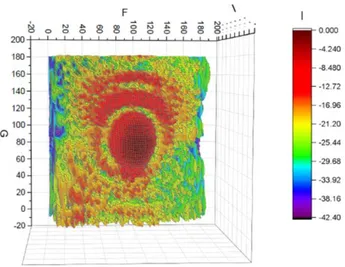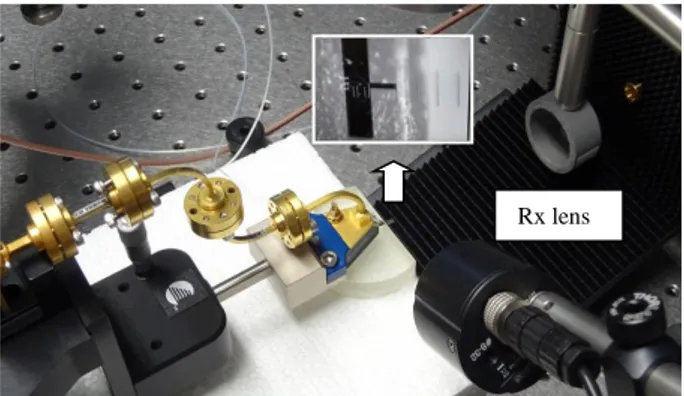HAL Id: hal-03223261
https://hal.archives-ouvertes.fr/hal-03223261
Submitted on 10 May 2021
HAL is a multi-disciplinary open access
archive for the deposit and dissemination of
sci-entific research documents, whether they are
pub-lished or not. The documents may come from
teaching and research institutions in France or
abroad, or from public or private research centers.
L’archive ouverte pluridisciplinaire HAL, est
destinée au dépôt et à la diffusion de documents
scientifiques de niveau recherche, publiés ou non,
émanant des établissements d’enseignement et de
recherche français ou étrangers, des laboratoires
publics ou privés.
300 GHz link enabled by Yagi-Uda antenn
Guillaume Ducournau, Fabio Pavanello, C Belem-Goncalves, Frederic
Gianesello, Cyril Luxey, Emilien Peytavit, Jean-Francois Lampin, M. Zegaoui,
M. Zaknoune
To cite this version:
Guillaume Ducournau, Fabio Pavanello, C Belem-Goncalves, Frederic Gianesello, Cyril Luxey, et
al.. 300 GHz link enabled by Yagi-Uda antenn. 2020 International Symposium on Antennas and
Propagation (ISAP), Jan 2021, Osaka (virtual), Japan. �10.23919/ISAP47053.2021.9391489�.
�hal-03223261�
300 GHz link enabled by Yagi-Uda antenna
G. Ducournau
1*, Fabio Pavanello
2, C. Belem-Goncalves
3, Frederic Gianesello
3, Cyril Luxey
4, Emilien Peytavit
1,
J.F. Lampin
1, M. Zegaoui
1,5, M. Zaknoune
11 Univ. Lille, CNRS, Centrale Lille, ISEN, UPHF, UMR 8520 - IEMN, F-59652 Villeneuve d’Ascq, France. 2Lyon Institute of Nanotechnology - École Centrale de Lyon, France
3 STMicroelectronics, 38920 Crolles, France
4 Polytech’Lab, Polytech Nice-Sophia, University of Cote d’Azur, 06903 Sophia Antipolis, France 5IRCICA-USR3380, 50 Avenue Halley BP 70478 59658 Villeneuve d'Ascq Cedex, France
*email: guillaume.ducournau@univ-lille.fr
Abstract – This paper presents the use of a Yagi-Uda
antenna on polymer substrate for 300 GHz data communications. The antenna is described and characterized in terms of radiation pattern in the 300 GHz band. Then, it is used and validated within a communication link. Using amplitude shift keying modulation at 10 Gbps and without any signal post-processing nor off-line detection, error-free performance is achieved.
Keywords — THz communications, Yagi-Uda antenna, 300
GHz band.
I. INTRODUCTION
With the new IEEE 802.15.3d standard established for future wireless communication systems in the 300 GHz band, it is now clear that this frequency range will be an enabler of future wireless networks [1]. Among challenges associated to this frequency band, high power sources with large modulation bandwidths, high sensitivity receivers with fast response will be system enablers, while the need of efficient/low cost antennas is still a key point. Here we demonstrate the use of a Yagi-Uda antenna on polymer substrate in a 300 GHz link, with amplitude coding with 10 Gbit/s error-free performance.
II. 300 GHz Yagi-Uda antenna
The Yagi-Uda antenna used in the THz link is fabricated on a cyclic olefin copolymer (COC). This material is suitable for high frequency operation, thanks to its low dielectric losses (tan() = 5.10-4 at 300 GHz) and good
electric insulating properties. The optical index of COC at 300 GHz is close to 1.53 [2]. Such material enables applications such as packaging, optics (lenses) and low-loss interconnects, as already reported in [3]. The full description of this antenna is given in [4]. This antenna consists of a coplanar waveguide (CPW) fed Yagi-Uda antenna employing 20 directors. The CPW ground planes act as reflectors. The circuit lies on a 110-µm-thick commercially available COC 6013 membrane. The design achieves a directivity higher than 15 dBi, with > -3 dB efficiency. While in [4] the radiation pattern was only measured in a single plane, here we measured the 3D radiation pattern using a probe-system (figure 1) prior to the integration of the antenna in the THz link. The
experimental setup was introduced in 2018 [5]. The measured radiation pattern shows a well-defined beam radiated in front of the Yagi-Uda antenna (figure 2).
Fig. 1. Probing of the Yagi-Uda antenna at 300 GHz in the 3D antenna measurement system described in [5].
Fig. 2. Measured normalized 3D radiation pattern of the Yagi-Uda antenna at 300 GHz.
III. THz link
First, a dual-tone 1.55 µm optical signal (tones separation = 2.4 nm/300 GHz) is amplitude modulated using a Mach-Zehnder modulator (MZM), later on amplified by an erbium-doped fiber amplifier (EDFA). This optically modulated signal is then injected in an
unitravelling carrier photodiode (UTC-PD), coupled to a 300 GHz CPW probe (Cascade Infinity type [6]). The signal is then radiated directly into free-space by the Uda antenna (figure 3). From the orientation of the Yagi-Uda antenna, the polarization of the THz wave is in the plane of the antenna, parallel to its directors. No additional lens is used at Yagi-antenna output. The THz link is 20 cm, and a 25 mm polymer lens is used at receiver side to focus the 300 GHz signal inside the receiver horn antenna. To align the receiver to the Yagi-Uda’s polarization, the horn receiver was placed to collect the horizontal THz incoming field. The receiver is composed of combination of amplifiers and Schottky-barrier diode (Zero-bias Detector, ZBD). Amplifiers used after ZBD are required to properly drive the bit error rate tester, enabling BER evaluation in real-time. No signal processing nor off-line detection was used in the experiment. The figure 4 shows the result of BER measurement with Yagi input power (measured in the probe CPW plane).
Fig. 3. Experimental setup: view of the waveguide-probe access of the Yagi-Uda antena, receiver lens and receiver horn antenna. 300 GHz absorbers were used to avoid any multipath effect, but finally were found to have no impact.
Fig. 4. Measured bit error rate for 10 Gbit/s communication. First tests were conducted at 300 GHz. An ‘error-free’ operation (ie BER < 10-11) was obtained for the THz link.
However, as shown in [4], the antenna optimum S11 was
obtained at slightly higher frequency than 300 GHz. Thus, as the bandwidth of transmitter and receiver was enough to enable the test of several carrier frequencies, we observed that, as expected, the behavior of the system was slightly better (2dB for BER = 10-11) using a 306 GHz carrier
frequency. Other frequencies, as well as full link budget analysis are still under investigation.
IV. CONCLUSION
We demonstrated the use of Yagi-Uda antenna on COC substrate for a 10 Gbit/s 300 GHz wireless link. Current analysis concerns the link budget to retrieve the antenna gain as well as distortion analysis, even if up to 10 Gbit/s, the eye patterns found were well defined.
ACKNOWLEDGMENT
The experimental setup was supported by the Agence Nationale de la Recherche (ANR) in the TERASONIC and SPATIOTERA projects (ANR-17-CE24 and ANR-19-CE24). Authors also thanks the Hauts-de-France regional council, the FEDER through the CPER Photonics as well as the Metropole Européenne de Lille (MEL) and I-site ULNE under the TERIL-Waves and DYDICO projects
. This work has received funding from Horizon 2020, the European Union Framework Programme for Research and Innovation, under grant agreement No. 814523 (THOR project). Last, the 3D antenna measurement system was developped in the framework of the ST-IEMN common laboratory, with the fruitful help of J.M. Mallet and C. Boyaval at IEMN.
REFERENCES
[1] T. Kürner and A. Hirata, On the Impact of the Results of WRC 2019
on THz Communications, 2020 Third International Workshop on
Mobile Terahertz Systems (IWMTS), Essen, Germany, 2020, pp. 1-3, doi: 10.1109/IWMTS49292.2020.9166206.
[2] F. Pavanello, F. Garet, M.-B. Kuppam, E. Peytavit, M. Vanwolleghem, F. Vaurette, J-L. Coutaz, and J.-F. Lampin,
Broadband ultra-low-loss mesh filters on flexible cyclic olefin copolymer films for THz applications, Appl. Phys. Lett. vol. 102,
pp. 111114-4, 2013.
[3] Emilien Peytavit, Cora Donche, Sylvie Lepilliet, Guillaume Ducournau, Jean-François Lampin, Thin film transmission lines
using cyclic olefin copolymer for millimeter wave and terahertz integrated circuits, Electron. Lett., 47, 7 (2011) 453-454, doi:
10.1049/el.2011.0369.
[4] Fabio Pavanello, Guillaume Ducournau, Emilien Peytavit, Sylvie Lepilliet, Jean-François Lampin, High-gain Yagi-Uda antenna on
cyclic olefin copolymer substrate for 300 GHz applications, IEEE
Antennas Wirel. Propag. Lett., 13 (2014), doi: 10.1109/LAWP.2014.2322628.
[5] C. B. Goncalves, E. Lacombe, C. d. Río, F. Gianesello, C. Luxey and G. Ducournau, Compact measurement setup for antennas
operating in the 220-325 GHz band, 2018 International Symposium
on Antennas and Propagation (ISAP), Busan, Korea (South), 2018. [6]
https://www.formfactor.com/product/probes/infinity/infinity-waveguide-probe/, accessed October 10th, 2020. -28 -26 -24 -22 -20 -18 -16 -14 -12 -10 1E-12 1E-10 1E-8 1E-6 1E-4 0,01 10 Gbps, 306 GHz 10 Gbps, 300 GHz BE R
Yagi-Uda input power (dBm)

